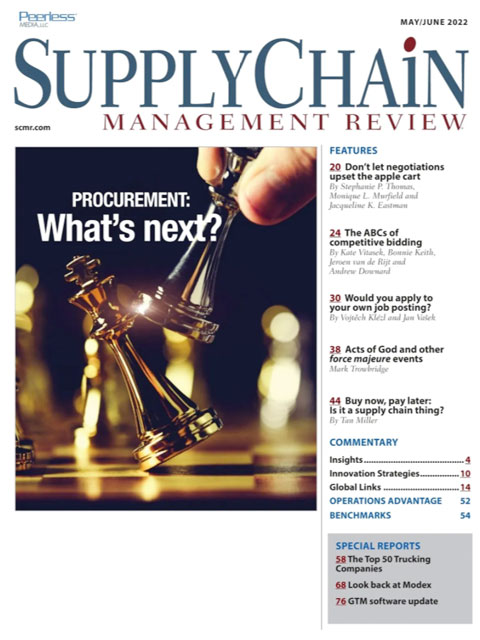Sorry, but your login has failed. Please recheck your login information and resubmit. If your subscription has expired, renew here.
May-June 2022
I recently returned from three days in Atlanta at the Modex trade show. Although advertised as a supply chain event, it’s really a materials handling automation show with a handful of logistics providers thrown in for good measure. Heading out the door to the airport, I had no idea what to expect. The two-year absence from the trade show and conference scene had me, and many of the individuals I spoke to before the show opened, wondering what’s next—not just for the show but for operations in general. If the turnout and the enthusiasm is any indication, I think supply chain is in pretty good shape these days, despite the disruptions we’ve… Browse this issue archive.Need Help? Contact customer service 847-559-7581 More options
For a buyer working in supply chain management to say their world has become more turbulent is a vast understatement. Many buyers may find themselves in a scenario similar to the one faced by Taylor. In this era of never-ending change, there is a practical need for supply chain buying managers to consider the relationship history with their key suppliers and their strategic expectations so that they can better understand and predict potential supplier negotiation behaviors and outcomes when environmental changes occur, both internal and external to their organizations.
Some buyers may have a collaborative (win-win) strategic situation with their key suppliers, in which there is information sharing and concern for the success of both firms. Other buyers may be facing a competitive (win-lose) strategic situation, where their suppliers emphasize their own short-term gains. After repeated negotiations, buyers learn to adjust to their suppliers’ negotiation styles given their past history. What happens then to buyers’ levels of trust when suppliers change their negotiation strategy to a different style after a history of doing it the same way?
Further complicating buyer-supplier relationships are environmental forces or changes, both internal and external, that are out of the control of the buyers and suppliers alike. Internal changes could include new executive leadership within the supplier organization that changes a strategic emphasis either toward or away from more long-term collaboration with their buyers. And, externally, these changes could include items such as price changes—either higher or lower—in key product components.
These types of changes occur in the chaos that supply chain managers have faced recently as they contend with the pandemic, the growth of inflation, global unrest and the “Great Resignation.” Given that a buyer’s relationship history with a supply chain partner creates expectations, any deviations in negotiation strategies create confusion and questions. For instance, what happens to the value of the relationship and the commitment to the relationship when environmental changes occur? Further, how is the supply chain relationship affected when, in addition to these internal or external changes, there are also changes in negotiation strategy behaviors?

This complete article is available to subscribers only.
Log in now for full access or start your PLUS+ subscription for instant access.
SC
MR
Sorry, but your login has failed. Please recheck your login information and resubmit. If your subscription has expired, renew here.
May-June 2022
I recently returned from three days in Atlanta at the Modex trade show. Although advertised as a supply chain event, it’s really a materials handling automation show with a handful of logistics providers thrown in… Browse this issue archive. Access your online digital edition. Download a PDF file of the May-June 2022 issue.For a buyer working in supply chain management to say their world has become more turbulent is a vast understatement. Many buyers may find themselves in a scenario similar to the one faced by Taylor. In this era of never-ending change, there is a practical need for supply chain buying managers to consider the relationship history with their key suppliers and their strategic expectations so that they can better understand and predict potential supplier negotiation behaviors and outcomes when environmental changes occur, both internal and external to their organizations.
Some buyers may have a collaborative (win-win) strategic situation with their key suppliers, in which there is information sharing and concern for the success of both firms. Other buyers may be facing a competitive (win-lose) strategic situation, where their suppliers emphasize their own short-term gains. After repeated negotiations, buyers learn to adjust to their suppliers’ negotiation styles given their past history. What happens then to buyers’ levels of trust when suppliers change their negotiation strategy to a different style after a history of doing it the same way?
Further complicating buyer-supplier relationships are environmental forces or changes, both internal and external, that are out of the control of the buyers and suppliers alike. Internal changes could include new executive leadership within the supplier organization that changes a strategic emphasis either toward or away from more long-term collaboration with their buyers. And, externally, these changes could include items such as price changes—either higher or lower—in key product components.
These types of changes occur in the chaos that supply chain managers have faced recently as they contend with the pandemic, the growth of inflation, global unrest and the “Great Resignation.” Given that a buyer’s relationship history with a supply chain partner creates expectations, any deviations in negotiation strategies create confusion and questions. For instance, what happens to the value of the relationship and the commitment to the relationship when environmental changes occur? Further, how is the supply chain relationship affected when, in addition to these internal or external changes, there are also changes in negotiation strategy behaviors?
SC
MR


More Finance
- Services sector sees growth in October, reports ISM
- Looking back at NextGen 2024
- Manufacturing again contracts in October, reports ISM
- NextGen Supply Chain Conference set for October 21-23
- Estée Lauder, Schneider Electric and S&S Activewear to receive NextGen End User awards
- 2024 Robotics Application Conference announces session, speaker lineup
- More Finance
Latest Podcast

 Explore
Explore
Topics
Procurement & Sourcing News
- Strengthening customer fulfillment: Building a strategic stakeholder network
- Trump picks former Wisconsin congressman Sean Duffy for DOT secretary
- Made in Mexico, manufactured by China
- Retail sales see gains in October, reports Commerce and NRF
- Geopolitical readiness in supply chains: Strategic challenges for leaders
- With capacity to spare, logistics real estate demand remains subdued
- More Procurement & Sourcing
Latest Procurement & Sourcing Resources

Subscribe

Supply Chain Management Review delivers the best industry content.

Editors’ Picks





